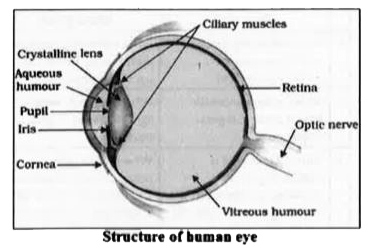Explain the structure and functioning of the human eye. How are we able to see nearby and distant objects ?Solution in Kannada
The human eye is the most preious and complex organ of the human body. It is a natural camera and a combination of several optical instruments which helps us to see the beautiful world around us.

The parts of the human eye are :
* Cornea - The transparent thin membrane at the front of the eye through which light enters. Its outer part is convex in shape and bulges outwards.
* Iris - Dark muscular ring-shaped diaphragm behind the cornea which controls the size of the pupil.
* Pupil - A hole in the middl of the iris which controls the amount of light entering the eye. In bright light, iris contracts the pupil and in dim light, iris expands the pupil so that suitable around of light can enter the eye to view the objects clearly.
* Crystalline lens - Soft and flexible jelly-like material made up of protein which can change shape to finely focus light on the retina. It acts as a convex lens.
* Ciliary muscles - They help eye lens to change its shape and hence its focal length according to distance of th object to be viewed.
* Suspensory ligaments - Extend from eye lens to ciliary muscles and hold the eye lens in proper position.
* Retina - A delicate membrane behind the eye which acts as screen on which the images are formed. it has a number of light-sensitive cells .rods. [which sense intensity of light] and .cones. [which sense colours].
* Aqueous humour - Watery liquid which fills the space between eye lens and the cornea.
* Vitreous humour - Transparent jelly-like substance which fills the space between eye lens and the retina.
* Blind spot - Small region at the junction of retina and the optical nerve. There are no light-sensitive cells in this region and hence vision is not possible.
Working of the human eye : Light rays from the objects enter through the cornea and pupil into the eye lens. The pupil regulates the amount of light entering into the eye. The outer surface of the cornea and eye lens together converge the light rays on the retina to form a real inverted image of the object. The light-sensitive cells of the retina get activated and generate electrical signals which are sent to the brain through the optical nerve. The brain interprets and processes these signals so that we are able to .view. the erect object.
While viewing a distant object, the ciliary muscles relax and the eye lens becomes thin, thereby increasing its focal length. While viewing a nearby object, the ciliary muscles contract, making the eye lens thicker and decreasing its focal length. Thus, we are able to see the nearby and distant objects clearly.
Topper's Solved these Questions
- THE HUMAN EYE AND THE COLOURFUL WORLDBook:ZEN PUBLICATIONChapter:THE HUMAN EYE AND THE COLOURFUL WORLDExercise:ZEN ADDITIONAL QUESTIONS SECTION - HIGHER ORDER THINKING SKILLS (HOTS)
Explore 26 Videos
- THE HUMAN EYE AND THE COLOURFUL WORLDBook:ZEN PUBLICATIONChapter:THE HUMAN EYE AND THE COLOURFUL WORLDExercise:ZEN ADDITIONAL QUESTIONS SECTION - SHORT ANSWER TYPE QUESTIONS - II
Explore 28 Videos
- SOURCES OF ENERGYBook:ZEN PUBLICATIONChapter:SOURCES OF ENERGYExercise:ZEN ADDITIONAL QUESTIONS SECTION (HIGHER-ORDER THINKING SKILLS [HOTS] )
Explore 14 Videos
Similar Questions
Rohan is not able to contract his iris properly due to defect in his eyes. Rohan would not be able to see :
(i) in dim light (ii) in bright light
(iii) nearby objects (iv) distant objects
View SolutionDraw a labelled diagram of the human eye. What is the significance of the blind spot ?
View SolutionState the areas where acid rains are most likely.
View SolutionHow are we able to see nearby and also the distant objects clearly?
View SolutionExplain the structure and functioning of human eye. How are we able to see nearby as well as distant objects?
View Solutionमायोपिक (myopic) नेत्र दूर की वस्तुओं की स्पष्ट रूप से नहीं देख पाता है या निकट की वस्तुओं को ?
View SolutionHow do we see distant and closer objects ?
View SolutionHow are we able to see nearby and also the distant objects clearly ?
View SolutionExplain the structure and functioning of the human eye. How are we able to see nearby and distant objects ?
View SolutionHow is a normal eye able to see distinctly distant as well as nearer objects? What is the distance of distinct vision?
View SolutionWhat is meant by the term ‘power of accommodation’ of human eye? How does it help a person to see nearby as well as distant objects clearly?
View SolutionHow are we able to see nearby and also the distant objects clearly?
View SolutionHow are we able to see nearby and also the distant objects clearly?
View SolutionExplain the structure and functioning of human eye. How are we able to see nearby as well as distant objects?
View SolutionWhich type of changes occur in thickness or curvature of an eye lens which enables the eye to see the distant and nearby object clearly ?
View SolutionHow is a normal eye able to see distinctly, distant as well as nearby objects ?
View Solution

